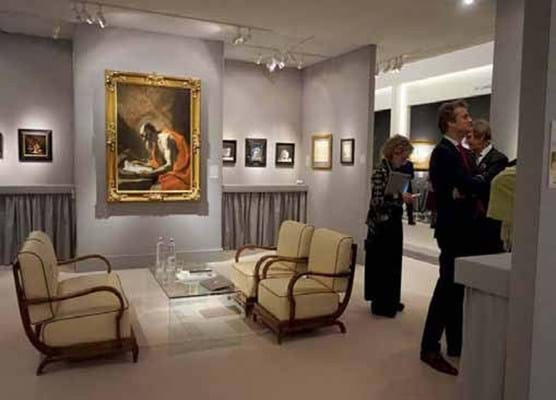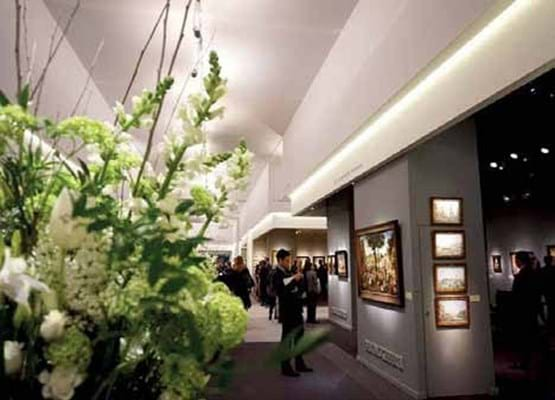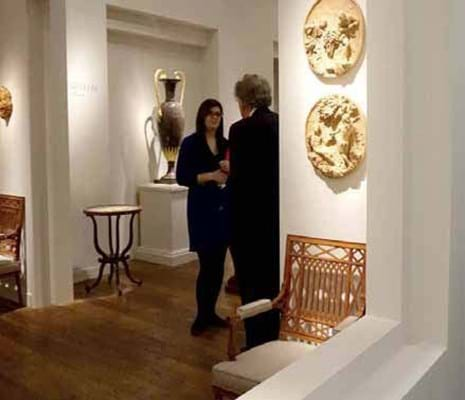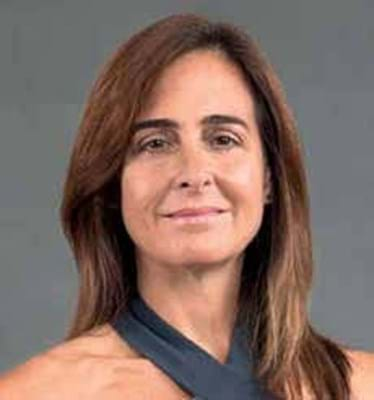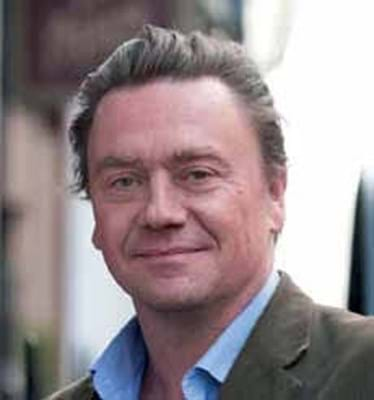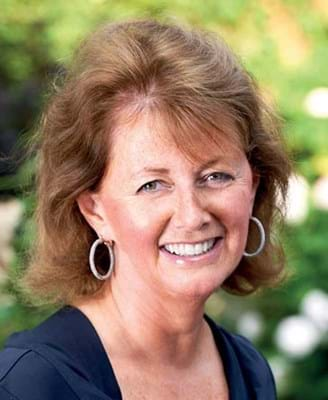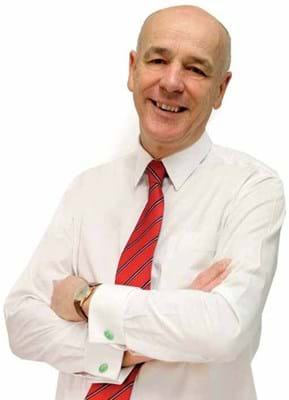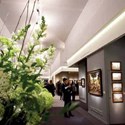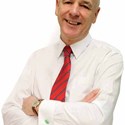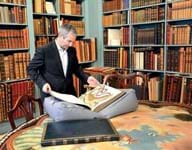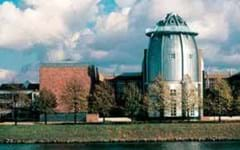Visitors
THE ART LAWYER & ADVISOR
Jessica Franses (left) is a barrister focusing on the art market and managing director of Vitruvian Arts Consultancy and visits TEFAF as an art advisor and lawyer.
She has been going to TEFAF for around 20 years, attending because her parents were exhibitors for that time with The Textile Art Gallery.
Indeed, her father set up a textile and carpet section called Textura which was once part of the fair.
Franses admits she might be “a little biased” about TEFAF’s role in the art market because of this family connection. “TEFAF sets the bar in terms of gallery excellence,” she says.
“It is also an excellent way of sourcing art for clients and intelligence gathering. It is a way of spotting trends and understanding what types of artists and artworks are popular and commercially desirable.”
Many visitors cite trendwatching as a core reason to attend TEFAF. Franses also goes to build relationships with dealers – both exhibiting or just visiting.
With her 20-year perspective, to what extent does Franses feel a fair that is 30 years old is maintaining its freshness? She believes TEFAF is still “fresh and relevant” because it has varied its exhibits – from works on paper to Contemporary art as well as design. “The integration and embracing of Contemporary works and some more affordable works allows the fair to be accessible to new collectors and helps it compete with other events,” she says.
Franses believes her fellow advisors would benefit from making the effort and spending the money to attend, as TEFAF offers a complete snapshot of the marketplace as a whole.
“For anyone interested in art and the art market, TEFAF is the equivalent of football’s Premier League,” she says. “Going there is essential to understanding the marketplace, seeing what the leading dealers are offering for sale and understanding what is available on the open market.”
THE MUSEUM CURATOR
TEFAF is well known for attracting museums from around the world, particularly those from the US looking for stand-out European Old Master artworks. The J Paul Getty Museum is one of these regular visitors.
Davide Gasparotto (right), senior curator and head of the paintings department at The Getty Museum, has visited for a number of years. He argues it is still worth attending TEFAF even if you are not buying, as he did when he worked at a smaller Italian museum.
He explains: “The acquiring possibilities of Italian museums are extremely limited, but Maastricht is probably the best opportunity to take the pulse of the market.”
TEFAF is, for Gasparotto, one of the major events for the art market during the year, for two reasons. “Dealers usually bring to TEFAF the best of their holdings. Added to this, over the years it has become an established meeting place for the people of the museum world and collectors.”
In this sense, the fair is as much about networking as it is about buying, especially as “in the last few years the tendency of the art market (and the preference of the dealers) is to deal more privately with top-class paintings”.
Despite fears that the New York event in October would detract from Maastricht, Gasparotto believes it is still very much worth visiting the Netherlands-based event too. “I attended the fair in New York last October – it was the first edition and it was a good one.
“But the feeling is totally different from Maastricht. In New York there are always so many things to do and you are not as focused on the fair as you are in Maastricht, which is a totally immersive experience.”
His tip for new visitors is to begin with your special focus area – for instance, he always starts by focusing on paintings. He says he is “very systematic” and tries “to see almost everything”.
THE ART ADVISORS
Anita Heriot, president of Pall Mall Art Advisors and Spencer Ewen, managing director of Seymours, are both regular TEFAF attendees and will be back again this year.
Heriot explains that the process starts long before doors open. “Many of the exhibitors are dealers we work with and will have already provided us with a first look of what they’re taking. In some cases we will have the pieces on hold for us to view when we get to the fair. But, of course, we are always excited to come across a little gem that we were not aware of.”
The two agree that TEFAF is the leader in its field. Ewan says that “as a general rule, the quality of the works on show is good: reliable and traditional with a strong vetting process”.
They will attend with clients and meet others there, even if the process can be a bit of a challenge. Ewen voices a common complaint – the journey there and back. “We love Maastricht the city and the actual setting but the travelling to and from is difficult for some of our clients.”
Heriot adds that “TEFAF is not a fair for all of our clients. Typically those that are attracted to the event are sophisticated and less focused on the newest and the latest ‘it’ artist.”
The fair changes internally and with the market. Ewen praised the organisers for the event’s ever-evolving design, particularly the less crowded feel of last year’s layout.
Heriot said Pall Mall has noticed increasing sales in the Impressionists category, in the market in general, and expects that to be reflected at TEFAF.
“With the uncertainty in the US economy and the opportunities for good deals with a strong dollar, our US clients are interested in acquiring in London and Europe.
“The Impressionist works have the appeal of being a ‘solid’ investment which is less susceptible to market fluctuations. We expect dealers to bring their best Impressionist works to TEFAF.”
THE ART INSURER
“I will be attending the fair for a variety of reasons,” says Clare Pardy of Hallett Independent. “I’ll go principally to meet up with existing and prospective clients but secondly, to enjoy the quality and diversity of the exhibits and to get a feel for values.”
The London-based art insurance brokers count Rupert Wace, Osborne Samuel and Richard Nagy among their clients who exhibit at TEFAF.
Hallett is organising a dinner party to entertain these and other clients during the event. “I think most people still regard TEFAF as the best fair in the world and as such, it is the best place to see a wide cross-section of museum-quality exhibits under one roof,” Pardy says. “As well as showing fabulous things, the quality of display is also exemplary, which is in itself inspirational.”
THE AUCTIONEER
A fine art fair in the middle of Europe might not seem the obvious place for a UK regional auctioneer to frequent. However, Guy Schooling, managing director of Sworders of Stansted Mountfitchet in Essex, recommends everyone in the industry to put TEFAF in their calendars.
Schooling (below right) tries to go to Maastricht every two or three years and is returning this year. He says: “Initially a friend said I should go but I always thought it was too difficult to get there. Eventually I was persuaded. It was actually very easy: fly to Eindhoven and hire a car.
When I arrived it blew my mind.”
The size of the fair is the big attraction for Schooling. “The quality there is like nothing else I had seen. What I like is the scale, quality and that there are so many different European galleries that I would not be able to see anywhere else.” Schooling particularly enjoys the Medieval and Renaissance carvings – “something we just don’t see in the UK and most of it is museum quality”. He adds: “I also love the Austrian secession furniture too. Being there is a real education.”
Among his tips for new visitors is to remember “always ask the price.
Don’t be shy – just ask”. He also recommends newcomers to be prepared to ask someone they know to give them a quick guided tour of the show as “it is very large”.
Despite the fair being surrounded by a “modern industrial hinterland”, Schooling notes the small historic centre with beautiful cobbled streets is completely dominated by TEFAF with “a great community spirit and a wonderful atmosphere”.
In summary, Schooling urges other art market professionals not to daunted by TEFAF and to attend. “It will open your eyes,” he says.

